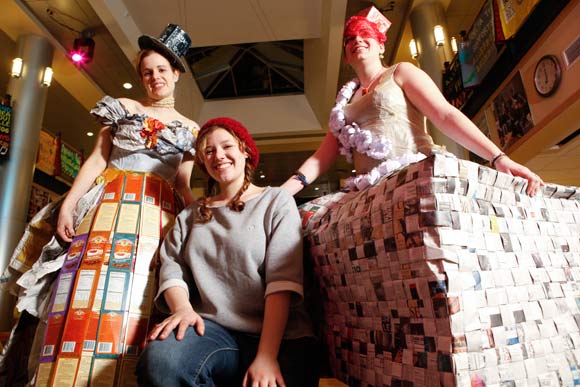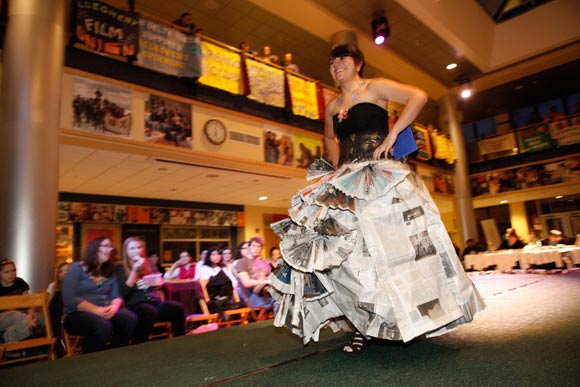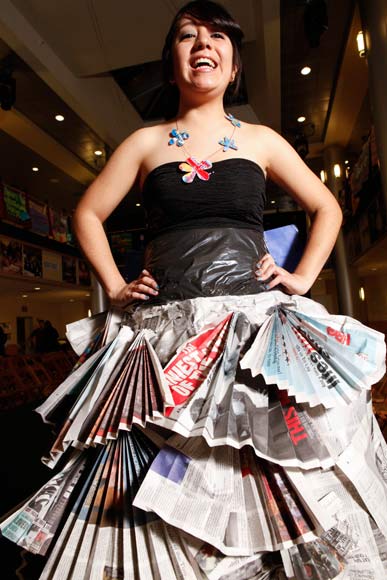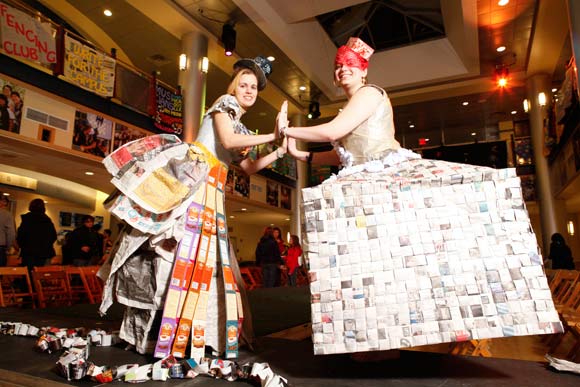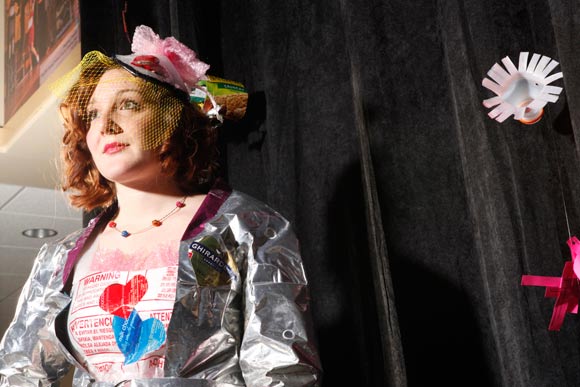Allegheny College is among five finalists announced late last month for the Institutional Excellence in Climate Leadership award presented by Second Nature, a national nonprofit that promotes education for sustainability.
That distinction likely has more to do with the green roof installed on the Vukovich Center for Communication Arts or that wind energy supplies the school's entire electricity usage.
But the school's annual Trashion Show probably has something to do with it, too.
“Trashion is reusing goods that would normally be thrown out by making an outfit and modeling it,” says Allegheny College junior Biology major Sarah Schombert, also one of the school's Eco Reps — students who help reduce the school's impact on the environment.
The third annual Trashion Show was held last Saturday, produced by Students for Environmental Action (SEA), which promotes the minimization of unnecessary consumption and waste disposal. The Trashion Show serves as “a creative and positive event in response to consumerism and waste disposal – a celebration of human innovation and power of adjustment to circumstances,” according to its Facebook page.
More than 25 models and designers participated in this year's event, using CDs, newspapers, tissue boxes, tea boxes and rain boots to create their own versions of fashion.
“The Trashion Show is important because, it escapes the typical gloom and doom of environmentalism while providing a positive experience in response to consumerism and waste disposal,” says sophomore and Trashion Show emcee, Nathan Malachowski.
The only requirements for the contest is that all “clothing” be made 100% from trash. Since Trashion’s debut in 2010, the event has grown to include trivia with prizes, lights (similar to real runway shows) and a D.J.
“Not only has the event grown in scale and popularity through the years, but it is more cohesive now too, which brings out a lot of people,” says Malachowski.
Some memorable outfits from past shows include one fashioned from Starburst wrappers and Capri Sun pouches. One outfit in particular that was created 100% from banana peels, and as one can imagine the time it would take to eat, peel and create this outfit. While these outfits seem as they would take months to create, Malochowski says, “Some designers invest weeks in their outfits and carefully plan, while others put together their outfits in a creative frenzy just days before the event.”
Besides caring about the environment and wanting to showcase their unique talents in the Trashion Show, Allegheny students supported a local organization, Crawford Area Residents for the Environment (C.A.R.E.). C.A.R.E is an organization that is raising money to stop a proposed Tire Incineration Plant from being built right in the local area by collecting donations at the Trashion Show. Although the show was advertised as free to attend, students did receive substantial donations which will help prevent this tire incinerator from being built.
“To make a nice looking outfit entirely from trash teaches a person how to really be resourceful. It also demonstrates that the “trash” we usually throw away could be repurposed, if not for clothes, then in some other more practical way,” said Schombert.
Says Malochowski: “This event is not about recycling; rather, it encourages students to move beyond recycling. It gives students the opportunity to look at their waste and figure out ways to turn it into something useful. In this way, it’s about upcycling, not recycling.”
KELLY CLAYTON is a senior at Elizabethtown College who plays field hockey, writes on a variety of subjects for publications and is the Editor of Tru(4)ia Magazine. Send feedback here.
PHOTOS:
Models Abby Beerman and Brittany Lafrate model dresses designed by Romy Schueller
Sharon Zavala models a dress of her own design, constructed of newspaper and plastic.
Detail of Zavala's dress
Model Kerry Bornstein, in a dress constructed using CD's and their cover art, with designer Anastasia Wooten.
Models Abby Beerman and Brittany Lafrate model dresses designed by Romy Schueller, constructed of tea boxes, old rain boots, newspaper, and tissue boxes.
Adrienne Tulet applies last minute lipgloss to model Aubrey Murano.
Aubrey Murano models a jacket and dress constructed from used coffee bags, packing supplies, and chocolate wrappers designed by Elizabeth Ozorak.
All photographs by HEATHER MULL
